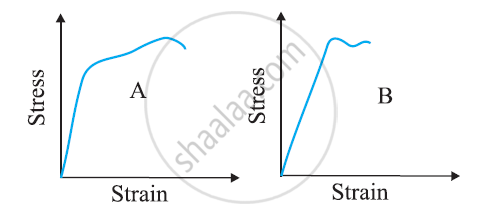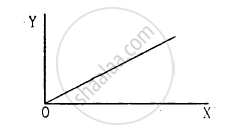Advertisements
Advertisements
प्रश्न
A steel wire of length 4.7 m and cross-sectional area 3.0 × 10–5 m2 stretches by the same amount as a copper wire of length 3.5 m and cross-sectional area of 4.0 × 10–5 m2 under a given load. What is the ratio of Young’s modulus of steel to that of copper?
उत्तर १
Length of the steel wire, L1 = 4.7 m
Area of cross-section of the steel wire, A1 = 3.0 × 10–5 m2
Length of the copper wire, L2 = 3.5 m
Area of cross-section of the copper wire, A2 = 4.0 × 10–5 m2
Change in length = ΔL1 = ΔL2 = ΔL
Force applied in both the cases = F
Young’s modulus of the steel wire:
`Y_1 = F_1/A_1 xx L_1/(triangleL)`
`= (F xx 4.7)/(3.0 xx 10^(-5) xx triangleL)`...(i)
Young’s modulus of the copper wire:
`Y_2 = F_2/A_2 xx L_2/triangle_2`
`= (Fxx3.5)/(4.0 xx 10^(-5) xx triangleL)` ...(ii)
Dividing (i) by (ii), we get:
`Y_1/Y_2 = (4.7xx 4.0xx 10^(-5))/(3.0xx10^(-5)xx 3.5) = 1.79:1`
The ratio of Young’s modulus of steel to that of copper is 1.79 : 1.
उत्तर २
For steel `I_1 = 4.7m`, `A_1 = 3.0 xx 10^(-5) m^2`
if F newton is the stretching force and `trianglel` metre the extension in each case, then
`Y_1 = (Fl_1)/(A_1trianglel)`
`=>Y_1 = (Fxx 4.7)/(3.0xx10^(-5)xxtrianglel)` ...(i)
For copper `l_2 = 3.5m`, `A_2 = 4.0 xx 10^(-5) m^2`
Now `Y_2 = (Fxx3.5)/(4.0xx10^(-5)xx trianglel)` ...(ii)
Dividing (i) by (ii) we get
`Y_1/Y_2 = 4.7/(3.0xx10^(-5)) xx (4.0xx10^(-5))/3.5 = (4.7xx4.0)/(3.0xx3.5) =1.79`
APPEARS IN
संबंधित प्रश्न
The stress-strain graphs for materials A and B are shown in Figure

The graphs are drawn to the same scale.
(a) Which of the materials has the greater Young’s modulus?
(b) Which of the two is the stronger material?
Read the following statements below carefully and state, with reasons, if it is true or false
The Young’s modulus of rubber is greater than that of steel;
Four identical hollow cylindrical columns of mild steel support a big structure of mass 50,000 kg. The inner and outer radii of each column are 30 cm and 60 cm respectively. Assuming the load distribution to be uniform, calculate the compressional strain of each column.
A student plots a graph from his reading on the determination of Young modulus of a metal wire but forgets to put the labels. the quantities on X and Y-axes may be respectively

(a) weight hung and length increased
(b) stress applied and length increased
(c) stress applied and strain developed
(d) length increased and the weight hung.
A copper wire of cross-sectional area 0.01 cm2 is under a tension of 20N. Find the decrease in the cross-sectional area. Young modulus of copper = 1.1 × 1011 N m−2 and Poisson ratio = 0.32.
`["Hint" : (Delta"A")/"A"=2(Delta"r")/"r"]`
If the yield strength of steel is 2.5 × 108 Nm–2, what is the maximum weight that can be hung at the lower end of the wire?
A steel rod of length 2l, cross sectional area A and mass M is set rotating in a horizontal plane about an axis passing through the centre. If Y is the Young’s modulus for steel, find the extension in the length of the rod. (Assume the rod is uniform.)
In nature, the failure of structural members usually result from large torque because of twisting or bending rather than due to tensile or compressive strains. This process of structural breakdown is called buckling and in cases of tall cylindrical structures like trees, the torque is caused by its own weight bending the structure. Thus the vertical through the centre of gravity does not fall within the base. The elastic torque caused because of this bending about the central axis of the tree is given by `(Ypir^4)/(4R) . Y` is the Young’s modulus, r is the radius of the trunk and R is the radius of curvature of the bent surface along the height of the tree containing the centre of gravity (the neutral surface). Estimate the critical height of a tree for a given radius of the trunk.
A boy's catapult is made of rubber cord which is 42 cm long, with a 6 mm diameter of cross-section and negligible mass. The boy keeps a stone weighing 0.02 kg on it and stretches the cord by 20 cm by applying a constant force. When released, the stone flies off with a velocity of 20 ms-1. Neglect the change in the area of the cross-section of the cord while stretched. Young's modulus of rubber is closest to ______.
The force required to stretch a wire of cross section 1 cm2 to double its length will be ______.
(Given Young's modulus of the wire = 2 × 1011 N/m2)
